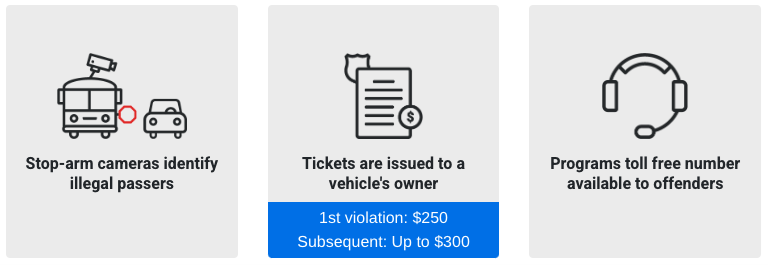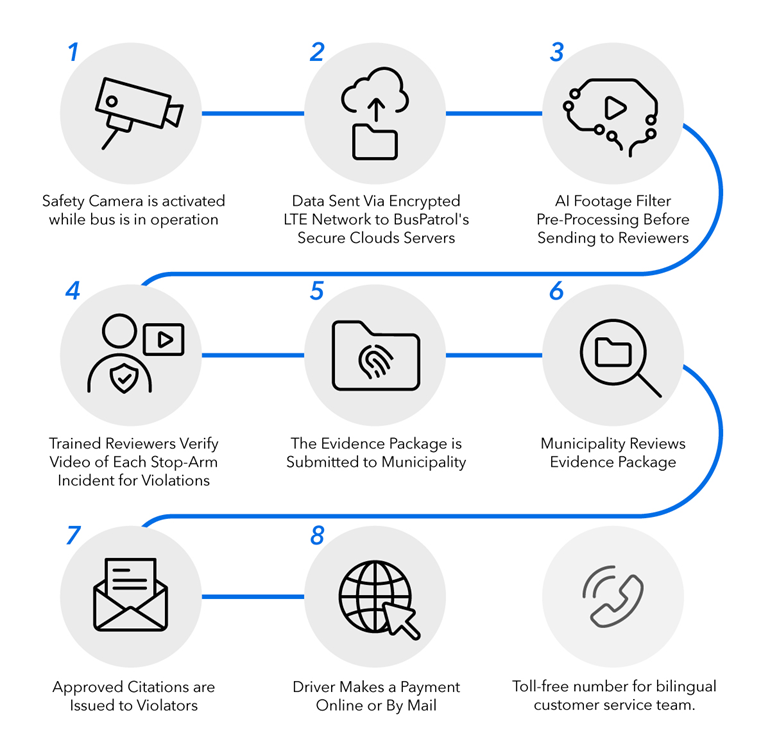School Bus Safety Program in Putnam County
Keep Kids Safe: It's the Law in New York State
About

In 2019, the National Association of State Directors of Pupil Transportation Services (NASDPTS) released data from their annual national survey indicating that more than 17 million stop-arm violations occur in the United States each year. Putnam County has launched a School Bus Safety Program to reduce the illegal passing of school buses and improve student safety
On August 6, 2019, New York State passed legislation (S.4524B/A.4950B) authorizing school districts to install safety cameras on school buses to catch drivers who unlawfully pass a stopped school bus and ensure student safety.
To speak to a representative about a safety violation, contact the AlertBus Customer Contact Center at 1-877-504-7080.
NYS Stopping Laws
Yellow flashing lights mean the bus is preparing to stop to load or unload children. Slow down and prepare to stop your vehicle.
Red flashing lights mean the bus has stopped for the purpose of loading or unloading children. Stop your vehicle and wait until the school bus resumes motion or until signaled by the driver or police officer to proceed.
Learn more at New York DMV.

Mahopac, Carmel, & Brewster school districts will be participating.
Every day 2.3 million children are transported by school buses throughout New York State. Data has shown that an estimated 50,000 drivers throughout the State illegally pass stopped school buses on a single school day*.
In New York State, a one-month study of 10 buses in East Meadow was conducted in 2019. Cameras recorded 615 illegal passes or roughly 2.3 per bus per day. This represents three times more than the number of tickets given out by Nassau and Suffolk counties during the 2018-2019 school year.
Reducing school bus stop-arm violations will significantly contribute to student and school bus safety in and around Putnam County. The automated camera system serves as a deterrent and education tool for motorists considering breaking the law and passing a stopped school bus.
While enforcement and education are critical in helping to change behavior, current models and legal frameworks in most states require that police officers catch motorists passing a stopped school bus with its red lights flashing to issue a citation. But with roughly 560,000 school buses traveling across more than 4 million miles of road and highway in the United States, conventional methods are not enough to effectively enforce the law to control these violations across the country. In addition, it permits local law enforcement officers to focus their energies on other high-priority tasks.
The School Bus Safety Program will provide data to partner school officials and municipalities to make informed decisions on school bus safety. The stop-arm violation data can also be leveraged by local law enforcement to add a physical presence to school bus stops with higher rates of infractions.
Entire school bus fleets will be outfitted with the latest safety technology, including safety cameras, DVR and storage devices, GPS, telemetry, LTE connectivity, [and internal cameras.]
In addition to this cutting-edge technology, the enforcement program is powered by software and processes and overseen by experienced safety professionals who coordinate with police, local officials, and school districts.
When a school bus is stopped with its lights and stop-arm activated, cameras capture incidents involving vehicles illegally passing the bus. Through cloud computing, data is sent to trained safety experts, who then review the footage and prepare evidence packages for municipalities.
By coupling technology-based enforcement with education and public safety campaigns, motorists learn how to adjust their behavior around school buses and children.
All school districts can opt-in to the program and benefit from an advanced school bus safety suite deployed across their entire fleets at no cost to the schools, taxpayers, or Putnam County. The violator-funded safety program handles the procurement, installation, management, and maintenance of the safety technology. In addition to a targeted effort to reduce the illegal passing of school buses in the community, the school district will benefit from access to cloud-connected internal cameras and BusPatrol's AlertBus platform for live-stream video and emergency alerts.
In the run-up to the program launch, Putnam County will work with BusPatrol to execute a community education and awareness campaign, including road signage, community announcements, and warning letters. The program will be preceded by a 30-day warning period, during which warning letters will be issued to drivers who fail to stop for school buses with no monetary penalty.

Stop-arm cameras identify illegal passers by license plate number. Tickets are issued to a vehicle's registered owner unless the automobile is proven stolen during the time of the offense. If someone other than the vehicle's owner was driving at the time, the owner can request a transfer of liability.
In most states, a first-time stop-arm violation carries a fine of $250. In New York state, subsequent violations within an eighteen-month period are subject to a $25 increase in penalty, up to a maximum of $300.
Data from other safety programs demonstrates that 98% of first-time offenders do not receive a second ticket and that 95% of drivers do not contest their ticket after seeing video evidence of their violation.

The diagram above is a representation of the camera systems used in the County.
BusPatrol's leading stop-arm enforcement program is built on a robust, guided, and secure process. When a vehicle illegally passes a school bus while the stop-arm is deployed, BusPatrol's multi-lens camera box captures the violation and the car's license plates from different depths and angles. The footage, GPS, and timecode data are stored locally on an onboard digital video recorder (DVR) unique to each bus.
The data relating to the incident and violation is sent via an encrypted LTE network to BusPatrol's secure cloud system. BusPatrol's artificial intelligence software filters all footage received from each bus before it goes to one of our safety specialists for review.
A BusPatrol safety specialist reviews the filtered footage. If they determine that the violation is indeed an offense, the specialist prepares an evidence package for use by law enforcement. The package is built in accordance with state law, complete with video footage, license plate number, make, model, driver information, GPS location, and a timestamp of the incident.
The evidence package is submitted to the enforcement entity via a secure cloud portal. The enforcement entity responsible for approving violations reviews the evidence package to determine if a violation has occurred. If approved, a ticket is mailed to the vehicle's owner, along with a link to the AlertBus Driver Education & Payment Portal, where they can view video evidence of their violation. The vehicle owner makes their payment online, through the mail, or in person in the municipal jurisdiction – tickets can also be contested through the relevant jurisdiction's civil court system.
When a school bus stops and flashes its red lights, traffic approaching from either direction must stop before reaching the bus:
- on a two-lane road
- on multi-lane highways
- on divided highways
Embed NYS Stopping Law Video / Video file also available in the Video folder in this pack:
Yellow flashing lights mean the bus is preparing to stop to load or unload children. Slow down and prepare to stop your vehicle.
Red flashing lights mean the bus has stopped for the purpose of loading or unloading children. Stop your vehicle and wait until the school bus resumes motion or until signaled by the driver or police officer to proceed.
Learn more at New York DMV.
Information from DMV New York
School Buses are Unlike Other Vehicles
School buses have bigger blind spots, take longer to stop, and need more room to maneuver than a standard vehicle. Buses should be treated differently than you would treat an average-sized vehicle. Drivers need to know how to react to a school bus in operation.
When you encounter a school bus:
- Slow down. School buses make frequent stops, so be patient and drive at a reasonable speed. Remember, school buses are required by law to stop at railroad crossings in addition to picking up and dropping off students.
- Be alert. Always be aware of children and parents waiting at a school bus stop or perhaps running to catch the bus before it departs.
- Come to a complete stop at least 20 feet away from the bus.
- Be extra careful to look around before moving your vehicle, as children may be walking in front of, behind, or on the side of school buses. Check for pedestrians - especially near schools, bus stops, playgrounds, parks, and behind parked cars.
Parents: You should discuss transportation conduct and safety rules with your children and share the safety tips below.
- Get to the bus stop at least five minutes before the bus arrives.
- When the bus approaches, stand at least three giant steps (six feet) away from the curb and wait away from the street.
- Wait until the bus stops, the door opens, and the driver says it's okay before stepping onto the bus.
- If you have to cross the street in front of the bus, walk on the sidewalk or along the side of the road to a point at least five giant steps (ten feet) ahead of the bus before you cross. Be sure that the driver can see you, and you can see the bus driver.
- Use the handrails to avoid falling. Be careful that clothes with drawstrings and bags with straps are not caught in the handrails or doors.
- Never walk behind the bus.
- After you get off the bus, walk at least three giant steps away from the side of the bus.
- If you drop something near the bus, tell the bus driver. Never try to pick it up because the driver may not be able to see you.
- Students can only embark or disembark at their designated stop.
- Check before you step.
- I see the driver. The driver sees me.
- Wait for the driver's signal to cross.
- Look left, right, and left again.
- Use a backpack or book bag to avoid dropping things.
- Horn means danger.
The primary focus of the School Bus Stop-Arm Safety Program is public awareness and education. The success of the program is measured in the reduction of stop-arm violations over time and not by the number of vehicles caught violating the law. Please review the information regarding school bus safety and the "danger zone" below.
More Sites Containing Information on this Topic:
The following information is provided for assistance.
To speak to a representative about a stop-arm violation, contact the AlertBus Customer Contact Center at 1-877-504-7080.
The Contact Center is available Monday- Friday (8 AM – 5 PM). English, Spanish, and French-speaking, customer service agents are available to address your inquiries. Please have your Citation Number ready when you call to expedite our service.
To view the violation video evidence online or to pay a violation by credit card, visit www.alertbus.com and enter the following information: Your citation number (example: NY-777777) and vehicle license plate number (no dashes or spaces), as listed on your citation.